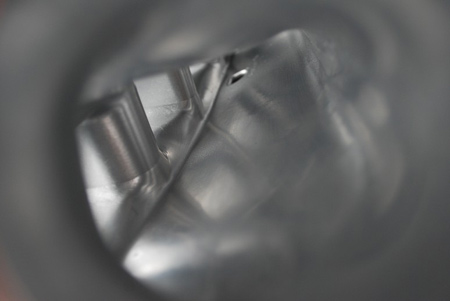Abrasive flow machining
Race engines are characterised by high levels of output, and are generally considered to be low in mass. Engineers spend a great deal of time, and companies spend a great deal of money, in trying to create ever-lighter components. Light components lead to lower forces for a given level of acceleration, and therefore generally lead to lower friction. Such pursuit of minimum mass in engine components leads us to produce evermore complex machined parts, and new manufacturing methods will soon allow us to reach new levels of complexity.
One fact that we are aware of is that poor surface finish can lead to premature component failure due to fatigue. Machining marks or other blemishes are often found to be the point from which fatigue cracks initiate. Our complex machining means that we are often not able to see all machined surfaces, and we may also be unable to reach them with tools in order to improve surface finish or remedy blemishes. There are some kinds of manufacturing processes where we simply want to remove the top layer of the surface. Cast-in curved pipes and tubes are examples of component geometry where the internal surfaces cannot be reached.
Abrasive flow machining, also known as 'extrude honing', offers the opportunity to improve surface finish in complex internal geometry. As the name suggests, the technique relies on a flow of an abrasive substance through, over or around a surface. As it flows over the surface, the viscous liquid, which contains abrasive particles, removes material preferentially where the ratio of surface area to volume is high. On the visible scale, burrs and sharp edges are removed, while on a much smaller scale, high spots are removed from the surface.

What we end up with is a smoother surface finish. When the surface finish is at a consistent and high level, further material removal will be at an even rate where the flow velocity is even. In practice, the abrasive may flow continuously through a bore (for example) or it may be pumped backwards and forwards. While the technique is most easily applied to bores and other internal geometry, it is possible to use the process on more 'exposed' geometry by constructing tooling to essentially turn the geometry to be processed into an internal surface, forcing the abrasive fluid to flow past the surfaces of concern.
The abrasive media is classified as a liquid, and behaves as such, but it is not necessarily something that is wet to the touch, and some very viscous media might be better described as a putty. The abrasives contained in such media are often oxide or carbide ceramics, such as aluminium oxide or silicon carbide; diamond is used for some applications. The harder abrasive particles, such as boron carbide and diamond, are used for flow machining of hard or difficult-to-machine metals, including tool steels, superalloys and titanium.
It is possible to apply the process to a wide range of geometries, from very small to large parts. It is often used to de-burr and improve the surface finish of spray holes on fuel injectors, for example.
Fig. 1 - Cast intake manifold which has been abrasive flow machined
Written by Wayne Ward